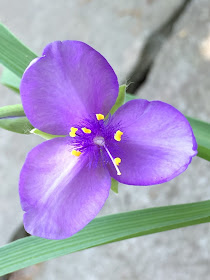A plant pundit comments on plants, the foibles and fun of academic life, and other things of interest.
Friday Fabulous Flower - spiderwort
Various species and cultivars of the genus Tradescantia (spiderworts) make very nice additions to your perennial garden and naturalized gardens, although they can be a bit weedy, so dead heading is a good idea. The flowers are fairly large, 1" diam, and blue to purple (like in the image); some cultivars are lighter, almost white, or more purple. They all have the sort of hairy looking center of the flower (the spider?). These are long filamentous hairs (trichomes) on the stamen filaments. Under a microscope the cells composing the hairs look rather like beads. They are mostly filled with a central vacuole, a water-filled sac that contains a purple pigment. The other cytoplasmic contents of the cells a pushed out against the cell wall occupying the ends of the cell with strands running along the cell wall. The large blobby sac is the cell's nucleus. According to biological history it was in exactly such spiderwort filament hair cells that Robert Brown, he of Brownian motion, first observed the nucleus of a cell (1833). It's a great specimen to observe the streaming of cytoplasm too.

No comments:
Post a Comment
Markup Key:
- <b>bold</b> = bold
- <i>italic</i> = italic
- <a href="http://www.fieldofscience.com/">FoS</a> = FoS